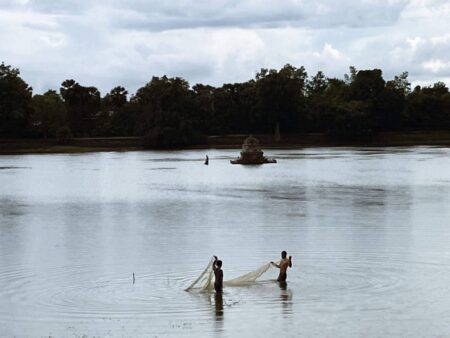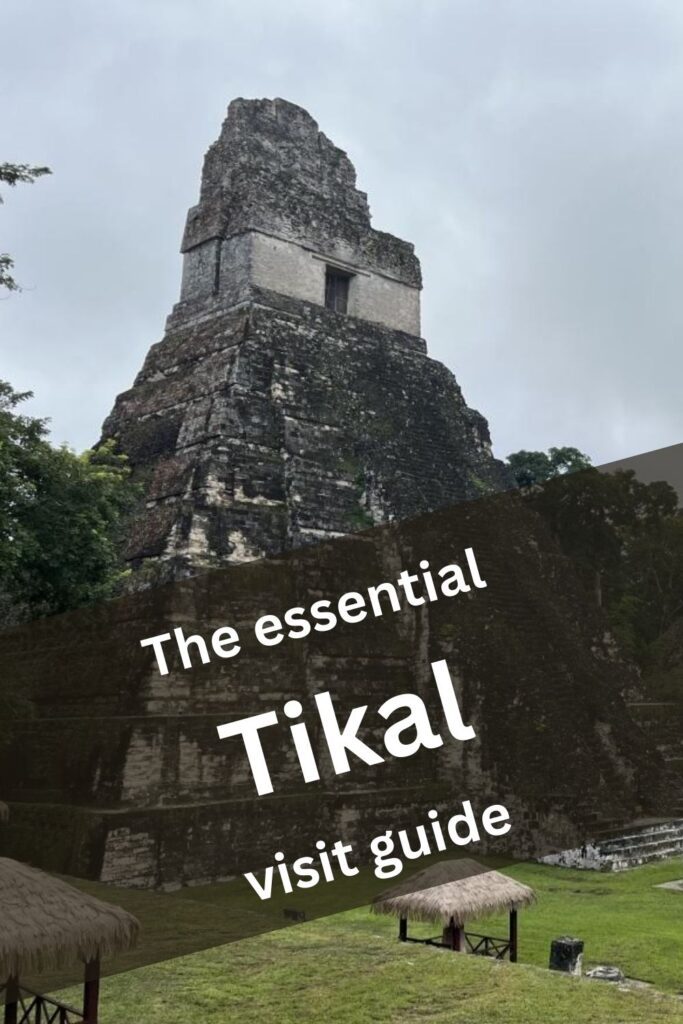When I think of jungle-covered ancient temples, two places come to mind: temples in South America, and Cambodia.
The city of Siem Reap, the second largest city in Cambodia, is home to the famous Angkor Wat temple, as well as all other famous nearby temples in the immense 9 km² great city of Angkor Thom, such as Ta Phrom, Ta Som, and Bayon. The Khmer Empire temple ruins are what attract the large majority of tourists to the city of Siem Reap and I went, like most, specifically to visit the ancient temples. Apart from Angkor Wat itself, which is rightfully considered a Wonder of the World (whatever that title means), all the other smaller temples are all different and have their own fascinating aspects. In general, there is something about structures devoured by the jungle that gives an aura of mystical, forgotten magnificence to the already wonderful complexes.

The city is also an interesting destination in itself, with its huge modern streets coupled with small hive-like inner roads. As a Western foreigner, just standing on the side of the road and watching the bustling life is a spectacle in itself. After my daily excursions, I would spend the evening just walking around, looking at the markets, the absurd but fascinating food such as dried fish, spiders, and freshly butchered chicken displayed on the boiling streets, the carts and motorbikes carrying the most disparate objects, the overcrowded tuk tuks, and the complete traffic mayhem. Everything about it is fascinating.

What to expect
- Insanely hot and sticky climate with humidity almost always between 70 – 80%.
- Immense (400 km²) archaeological park with temples scattered everywhere and mostly swallowed by the jungle rainforest.
- Incredibly friendly people.
- Very low prices, with the US $ being preferred over the national Cambodian Riel.
- Bustling streets: between shops, food vendors, businesses, markets, and intense traffic, the streets are incredibly lively.
- Delicious food (loklak is a must-try dish)
- There is very noticeable inequality and poverty, especially in such a tourist-centric city.
- A strong religious component with widespread Buddhism (over 90% of the population) and Buddhist monks roaming around.
Tips & Impressions
- Cambodians are extremely friendly and polite to the point of deference. For example, if a driver or server does not understand something, it is unlikely that they will ask for clarification. You will most likely receive smiles no matter what so keep that in mind.
- Sunblock and mosquito repellent go without saying. You never see it in Indiana Jones and Tomb Raider movies, but that layer of glistening sweat from the heat and humidity is generally covered in insects.
- Don’t bother changing your money in the local Riel currency, as dollars are accepted wherever you go (except in local street markets). Also, 100 dollars is more or less equivalent to 400,000 Riel so your wallet would explode from the amount of banknotes.
- Most likely, your whole visit to Siem Reap is to see the Angkor Wat. Although it is the most famous, it is only one of the more than 1000 temples scattered across the immense Angkor archaeological park. As such, you will need a couple of days to visit the complex and enjoy it fully. There are 3 visitor passes available for 1, 3, and 7 days. Unless you are prepared to do some serious temple exploration, avoid the 7-day pass, but also don’t limit yourself to the single-day pass. This also depends on the season in which you travel, as during the winter it is more sustainable to go around and more temples can be seen in a day, whereas during the rainy season, the heat and humidity and frequent showers in the afternoon and evening will probably slow you down and you will need to take more time.
The Angkor Complex
The most famous temple, Angkor Wat, is the highlight of any trip to Cambodia and one of the most important sites in all of East Asia.
However, the entire site is immense, with an area of 400 km². Only visiting the major, most famous temples requires one to move around the ancient city of Angkor Thom (the “Great City”), which itself covers an area of 9 km².
As such, it is not possible to visit it on foot. Most people hire tuk-tuk drivers who will happily drive you outside of various dispersed temples, wait for you to visit them, and escort you to the next. Many offer to accompany as tour guides. Generally, this is the safest and most comfortable way to explore the complex, as a driver can be booked for the entire day. Alternatively, one can rent a bike or car and drive around themselves, as there are a few roads that are in perfect condition and accompanied by clear road signs and directions.
Entrance to the site requires a ticket, which needs to be purchased beforehand at the central office. Given the size of the site, visiting in one day is not nearly enough and either the 3- or 7-day passes should be purchased.
1-day ticket – $37 USD
3-day ticket (valid for 1 week) – $62 USD
7-day ticket (valid for 1 month) – $72 USD
Children under 12 can enter for free but must show their passports.
Tickets issued after 5 p.m. are valid for the next day.
Country Info
- Language: Khmer is the official language.
- Population: 16,449,519 (est. 2018)
- Ethnic Groups: Khmer 90%, Vietnamese 5%, Chinese 1%, other 4%
- Religions: Theravada Buddhist 95%, other 5%
- Currency: Cambodian Riel (KHD). US dollars are widely accepted, if not even preferred, to the local currency
- Credit Cards: Except in upper-class hotels and high-end restaurants, cards are not always accepted.
- Electricity: Socket types A, C, G, 230 volt / 50 hertz
Check the Cambodia page for more country general information
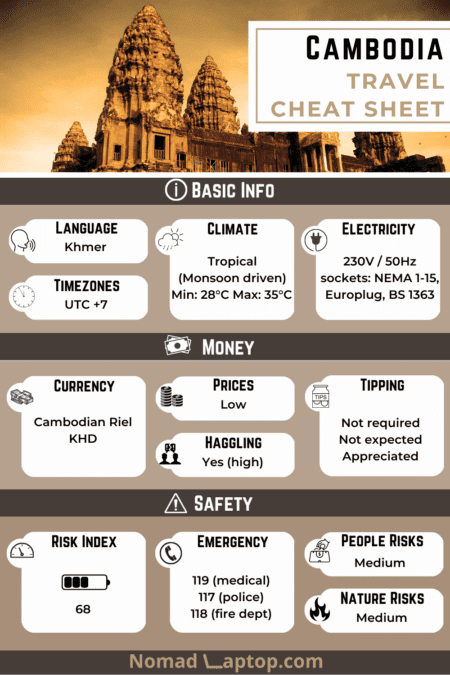
Safety
- Safety: Siem Reap is the most touristic city in the country and as such, it is very safe. That being said, the general poverty of the country brings with it a high number of beggars and street vendors who might attempt scams. Walking around at night may create some nervousness simply from the high attention that tourists receive. However, the major threat for tourists doesn’t go beyond small crimes such as pickpocketing.
- Emergencies numbers: 119 (emergency medical services), 117 (police), 118 (fire department)
Weather
As in other regions of the tropics, seasons are split more between the rainy and dry seasons, rather than the four commonly known seasons.
The weather is extremely hot and humid all year round but autumn and winter all the way to early spring (March and April) are the months that are favored by tourists, with temperatures remaining high and a drier climate. Archaeological sites like Angkor Wat are assaulted by tourists during this season.
During the wet season, prices are lower but most importantly, the crowds in these places are fewer.
In this period there are frequent rain showers that arrive in the afternoon and are short-lived, so the cloudy skies may ruin a sunset photograph, but nothing more.
Etiquette
- Although the temples belong to the now defunct Khmer empire, many of them are Buddhist, and generally all are considered sacred. As such dress appropriately with shoulders and knees covered, avoiding bright colors or strong perfumes.
- Cambodians greet through the Som Pas, with palms together, in a manner of prayer. Similarly to the Thai Wai, not returning such a greeting is considered very disrespectful.
- Regarding religious artifacts, needless to say, Buddha statues, independently of whether they are in ruins or not, are sacred objects, and should not be touched, or stood on the altar where they are.
- When it comes to the temple/Wat, shoes or sandals must be removed when entering it.
- More than 90% of Cambodians are Buddhists and Buddhist monks are widespread. When interacting with them, apart from the expected customs around a religious figure, some lesser-known behaviors to follow are for example that one should never stand when talking to a seated monk and that visitors should sit with legs bent and on their feet, with these pointing backward away from the monk. Also, women must not touch a monk and if handing an object, this should be placed within the monk’s reach and not handed directly.
Flora & Fauna
- The hot rainforest climate and muddy soil allowed the Cambodian jungle to completely swallow the Angkor complex after the fall of the Khmer empire.
- The invasive species of plants, most notably the fig trees, envelop with their immense roots some of the temples, most famously the temple of Ta Phrom, giving an even more mysterious and forgotten aura to the sites.
- Despite more than half of the entire area of Cambodia being comprised of forests and the country has a rich biodiversity, when it comes to wildlife, during the 1980s and 1990s, the large rainforest of the Angkor complex was stripped of wildlife from deforestation and poaching. Fortunately, in the past decade, successful conservation attempts have helped bring back the wildlife of the region.
- Despite this animal repopulation, you will not find any tigers or elephants. Most of the mammals are monkeys, especially gibbons and macaques. Among the reptiles and amphibians, lizards can be seen scurrying around and frogs in the muddy plains.
Deals for Siem Reap
Travelogue
Accommodation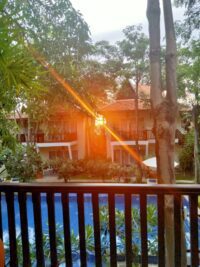
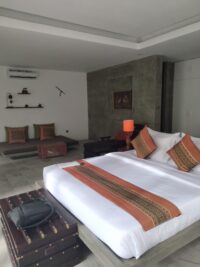
My accommodation was Mane Village Suites, a beautiful complex with large, spacious rooms with Khmer decor. The only downside is that the hotel is near a primary school and a Buddhist temple, creating a large amount of noise, albeit characteristic and not bothersome. The wonderful pool is visited at night by swarms of bats, which hunt the insects attracted by the night lights of the pool, creating an eerie yet wonderful spectacle.
Angkor Wat
អង្គរវត្

About
The whole temple complex is the largest religious monument in the world.
Built in the 12th century, originally as a Hindu temple dedicated to Vishnu, it was later converted to a Buddhist temple, still used to this day.
It is a prime example of Khmer architecture and was designed to represent Mount Meru, home of the devas in Hindu mythology. At the center of the temple stands a quincunx of towers, and the complex is surrounded by a moat and large outer wall, typical of Khmer cities, and symbolizing the mountain ranges and ocean around the sacred mountain.
During the last decades, the site has seen a steady growth in visitors from all over the world and the temple is now constantly swarming with tourists.
Impressions

I have seen the Great Wall of China, the Colosseum, Petra, and Machu Picchu. All belong to the so-called (and much criticized) New Seven Wonders of the World and I think that Angkor Wat deserves to be part of it, and I actually think that it is “better” than any of these three.
First off, the negative aspects: as expected, the whole temple complex is a tourist trap, with hundreds of people swarming all the surroundings and interior. Also, the heat and humidity are almost unbearable and I think that it was the time that I sweated the most without doing some intense exercise. Today’s the fourth time I have experienced total heat exhaustion.
Despite being interested in mythologies and religions, my knowledge of Hindu practices and history is quite low so I missed a lot of the meaning and probably some major details. But I enjoyed the experience nonetheless. Every naga statue, apsara, or bas-relief and every entrance through a gallery or courtyard was filled with surprise and bewilderment.
I traversed the temple, climbed the incredibly steep stairs to the central tower (which really instilled the feeling of climbing Mount Meru), and then found a nice place to rest with a view away from all the tourists, where I unsuccessfully tried to return to the temperature of a human being. I then went straight through to one of the gates, where I was completely alone except for the ever-present mosquitoes and then crossed to the east side to spend some time surrounded by monkeys, which thankfully must have been so accustomed to tourists that they were not bothered by my presence there.
That being said, the complex is breathtaking from the first step taken through the bridge, which crosses the large moat that surrounds it. We are all tourists and have to take the photo of the temple reflected in the pool of water and the front-facing picture but when you step out of the main avenue leading to it and find a quiet spot on the side, there is a peaceful yet awe-inspiring feeling to just sit there surrounded by bas reliefs, immersed in the smell of incense and observe the surrounding jungle and the passing monks.
Once again I stubbornly did not take a tour guide, primarily because I wanted the freedom to just wander around and then wait to see the sunset (which I was not able to due to the clouds that formed in the evening)
Bayon
ប្រាសាទបាយ័ន

About
Part of the Angkor Thom city, built in the 13th century after the sacking of Angkor Wat, the Buddhist temple of Bayon has an architecture strongly in contrast to the classical Khmer design of Angkor Wat, with a baroque style, and an incredibly more compact structure.
Its most famous and distinguishing characteristic is the giant smiling Buddha stone faces that surround every tower of the temple, totaling 216 faces.
Impressions
At the exact center of the immense Angkor Thom complex which spans an area of 9 square km, sits the temple of Bayon. All four gates and straight roads lead to here. It is a Buddhist temple with the distinctive feature of having many serene stone faces on the several towers of the three terraces that compose it.
What struck me the most about Bayon was how compressed it was. I think that a person with claustrophobia would have a hard time exploring it. It is strange that the Angkor Thom complex would have such a comparatively small main temple with respect to the five-times smaller Angkor Wat complex and its immense temple.
Ta Som
ប្រាសាទតាសោម

About
Together with Ta Phrom and Preah Khan, the temple of Ta Som has been left largely unrestored, and provides a stark contrast to the other clean temples.
Like the other two, Ta Som has been swallowed by the Cambodian jungle, leaving its stones to be devoured and constricted by the immense roots of Fig trees.
The temple is relatively small, with a central hall from which 4 galleries stretch out.
Impressions
Ta Som is a small temple, famous among tourists for having one of the entrances strangled by a giant fig tree. Like its larger, more famous cousin Ta Phrom, it has been left largely intact and as found by archaeologists so it is the first that I see that has been engulfed by the surrounding jungle as opposed to Angkor Wat. It is also the first temple which I visited built in Bayon style with the characteristic Buddha face stone carvings.
Initially, I was extremely lucky to be the only one in the temple walls and could take all the time to sit and relax surrounded by the moss-covered stone and all the different reliefs of apsaras. When some other people arrived, an Asian tourist decided to walk right to the center of the temple, from which four long corridors stretch out, and play some infantile game on maximum volume on her phone for the joy of all visitors and phototakers.
Ta Prohm
ប្រាសាទតាព្រហ្

About
The temple of Ta Phrom (originally Rajavihara, “Royal Monastery”), together with Preah Khan, was left largely unrestored due to its picturesque merging with the surrounding jungle. The size of the tree roots covering the temple resembles immense boa snakes strangling the stones.
It is a flat complex as opposed to the pyramidal and mountain-inspired other temples of the Angkor site and like Preah Khan it is built as a series of enclosing walls and galleries. This, together with the stone rubble and immense trees blocking paths, provides a maze-like quality to the ruins when visited today.
Impressions

Possibly the most famous and visited temple after Bayon and Angkor Wat, this temple was initially underwhelming. There are several bracings to keep the structures and walls standing and block pathways. Also, although I was fortunate to not find as many people as apparently there usually are, whichever route I took, I stumbled into a new group of noisy children who mistook the place for an amusement park.
However, all of this was behind me after I entered one of the four concentric walls, where everything started to change. The temple is a flat structure, and all these walls, surrounding galleries, and inner pathways create a literal maze. Moreover, if Ta Som had been engulfed in the jungle, Ta Phrom was been completely devoured by it. Almost every major wall and route is traversed and wrapped by the roots of the strangling fig trees, which appear to be otherworldly large. This inspired a real sense of exploration and journey and I have to admit to having at one moment checked the maps app on my phone to have a vague idea of where I was.
Neak Pean
ប្រាសាទនាគព័ន្ធ

About
Neak Poun, (or Neak Pean, or Neak Poan, meaning “The Entwined Serpents”), was originally designed for medical purposes.
It is based on the ancient Hindu belief of balance with four connected pools representing Water, Earth, Fire, and Wind, each connected to the central water source, the main tank, by a stone conduit. Each pool is overseen by statues of four animals namely Elephant, Bull, Horse, and Lion, corresponding to the north, east, south, and west quarters.
Impressions
Close to Preah Khan is Neak Poun which is an artificial island with a temple in the center, within another artificial baray typical of the Khmer Empire temple architecture.
To reach the temple, one has to traverse the baray, which at the time I went was done through planks laid on metal stilts as the main bridge was under renovation. This is followed by a short, winding path between lianas until the reservoir is found.
Although the temple is small and reaching it is neither comfortable nor an enjoyable walk in the jungle, I was entertained by the short journey because, after the previous temple, I was now in this kind of videogame narrative, and this became “the poisoned swamp level.” So it was important to walk slowly, carefully stepping on the unstable planks; otherwise, you know, poison D.O.T.
Preah Khan
ប្រាសាទព្រះខ័ន
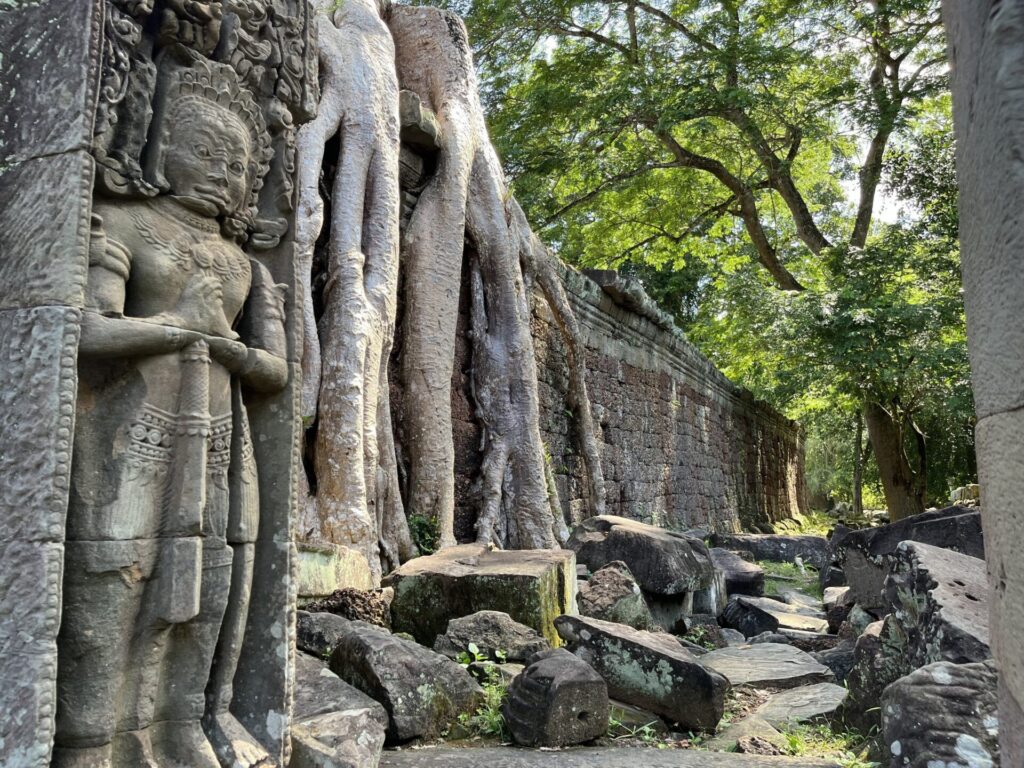
About
Preah Khan (“holy sword”), is also a flat temple like Ta Phrom, but larger in scale and slightly less devoured by the jungle.
It is surrounded by a moat and each of the 4 entrances, oriented to the 4 cardinal points, has lines of statues of devas and asuras carrying nagas over the bridges.
Impressions
Preah Khan is also a flat temple that apparently hosted around 100,000 people. It consists of a series of rectangular galleries surrounding a central stupa. I counted 12 separate doors to traverse, and half of them had their own surrounding gallery.
In general, when traversing a museum, building, or any sort of exploration, there are two major approaches: breadth-first, where one explores the different pathways in a “layered” manner, stopping at every new “level” to explore the ones left behind before proceeding forward. And depth-first, where one follows a pathway to the end and then backtracks and follows another path to the end. Both iterate until all branching pathways have been traversed or the objective is found.
And here is where my videogame completionist quirks kick in. Because you never go into depth first. You would risk missing out on important secrets that are needed for the next levels; getting the “right” road and basically finishing the game; getting to a boss room and not being able to go back. So it’s always a breadth-first search. Unfortunately, it doesn’t work well with mazes or concentric topographies and from a purely navigational perspective, it’s also easy to lose yourself by doing all these small steps and backtracks.
So every time I went through a door and saw 3 separate pathways branching out, it kind of annoyed this completionist (or autistic) side of mine. Anyway, enough with videogame exploration approaches based on tree traversal algorithms.
Pre Rup
ប្រែរូប
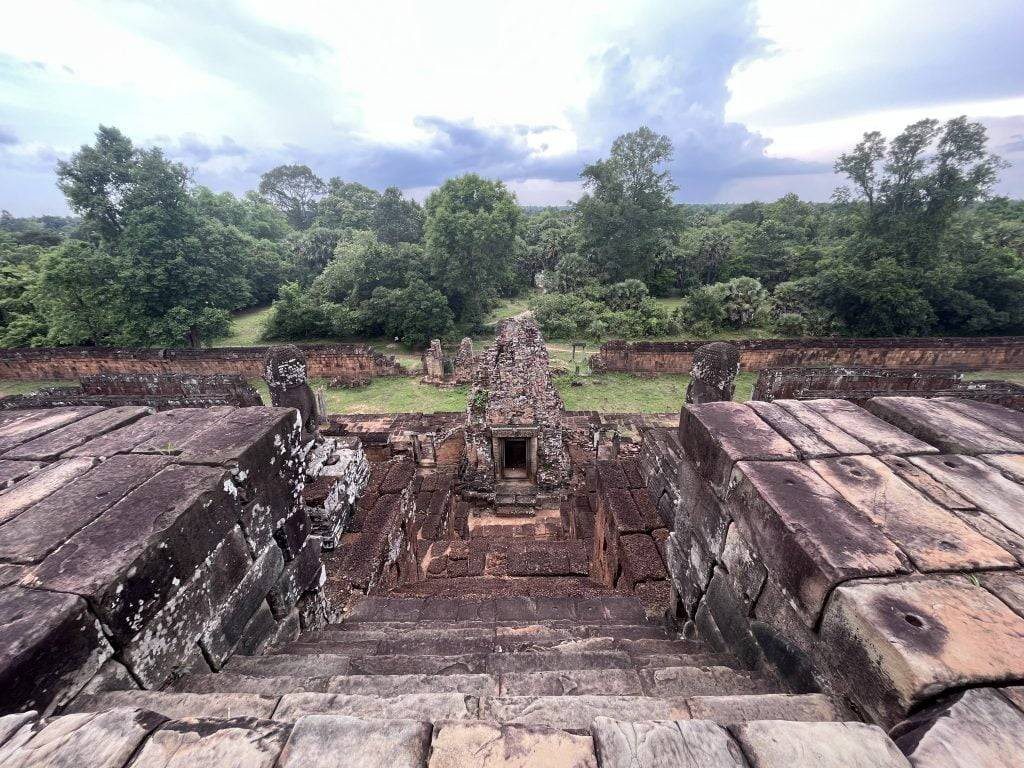
About
Pre Rup (“turn the body”) is a Hindu temple, and similarly to Angkor Wat, is a tall pyramidal structure meant to resemble Mount Meru
Impressions
Pre Rup resembles Angkor Wat in architecture by having the 4 towers surrounding the taller central shrine dedicated/home to the deity Shiva. I enjoyed the tranquility of the site and, as for Angkor Wat, the steep climb to the center and the view of the Cambodian jungle.



